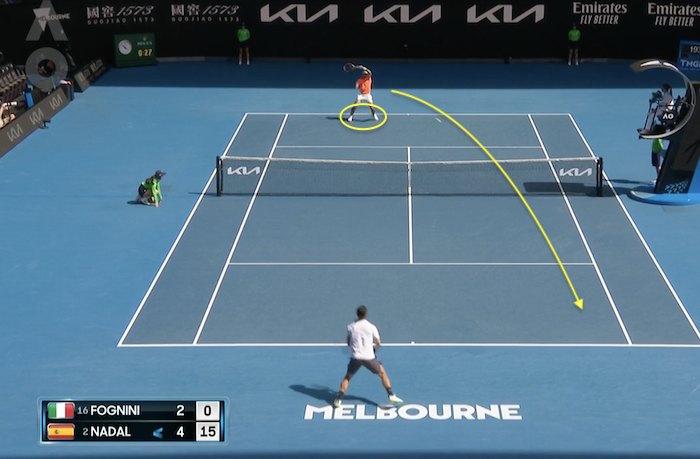G’day,
Serve +1.
Rafael Nadal hits a serve. Then the party begins.
The +1 is the very next shot after the serve, and through his first four matches at the 2021 Australian Open, that shot has been a forehand more than three out of four times. It’s not what opponents want. It’s a pattern of play that Rafa obsesses about to help him hold serve.
Hit a serve. Hit a forehand. Rinse. Repeat. Hammer time for the next victim. Have you seen the trophy room at the Rafa Nadal Tennis Academy?
This is Rafa’s line-up so far in Melbourne this year.
- Defeated Laslo Djere 6-3, 6-4, 6-1
- Defeated Michael Mmoh 6-1, 6-4, 6-2
- Defeated Cameron Norrie 7-5, 6-2, 7-5
- Defeated Fabio Fognini 6-3, 6-4, 6-2
- Next up: Stefanos Tsitsipas in the quarters
Through the first four matches, Rafa has hit a forehand 77% of the time after a serve = 151 times out of 195.
On the one hand, this pattern of play is so obvious that opponents should be able to stop it. But they can’t. Because Rafa basically invented this specific “game”. He knows the angles and ball speed and player movement and balance and anticipation with his eyes closed. His opponents are just along for the ride. Helping him fill that trophy cabinet.
How good is this strategy? Off. The. Charts. Good.
Of the 151 times Rafa has started the point with a serve and a forehand, he has won 98 of them. That’s good for 65%. That’s crushingly good. It’s an outrageously high win percentage for a grouping of points that almost all fall into the category of “baseline” points. Yes, there is a sprinkling of net points in there as well, but precious few.
So, Rafa has hit a Serve +1 forehand 77% of the time and won 65%. That an A+ strategy any way you want to slice it.
But we need to break it down a little more to figure out what’s really going on with this pattern of play. The first thing to understand is cutting the court up into four areas – A,B,C,D.
Court Areas – A,B,C,D

If Rafa was standing in the middle of the court, areas C and D are forehands for him and aread A and B would be backhands. Sounds good in theory. Not in Rafa’s world.
Here’s where Rafa was standing when he hit the 151 Serve +1 Forehands.
Serve +1 Forehand Location
- Position A = 33 (22%)
- Position B = 65 (43%)
- Position C = 37 (25%)
- Position D = 16 (10%)
- Total = 151
Rafa doesn’t see the line down the middle of the court signifying Deuce court and Ad court. There is no left side and right side of the court for him. He is looking for forehands absolutely everywhere he can find them for the first shot after the serve.
- Deuce Court Serve +1 Forehands = 65%
- Ad Court Serve +1 Forehands = 35%
It does not get any more clear than that. Opponents hit 98 return of serves to Positions A and B that were supposed to be a Serve +1 backhand for Rafa, but he turned it into a Serve +1 forehand. The Deuce court is the real domain of Rafa’s lethal Serve +1 play.
Rafa is running this play so effectively at the moment that there is no real hole or weaker spot that is delivering a sub-standard win percentage. He is crushing in all areas.
Serve +1 Forehand Win Percentages
- Position A = 61%
- Position B = 65%
- Position C = 70%
- Position D = 63%
That’s tough to gameplan against. Here’s where Rafa is hitting his Serve +1 forehands.
Serve +1 Forehand Direction
- To Position A = 75 (37%)
- To Position B = 27 (14%)
- To Position C = 29 (15%)
- To Position D = 66 (34%)
Rafa’s favorite combination of all is to go from Position B to Position A. That’s what he prefers above all else. Below are four screenshots so you can get a feel for his favorite strategy.




You may be wondering how good Rafa’s Serve +1 backhand is also performing? From another planet as well in Melbourne this past week.
Overall, Rafa has hit 77% Serve +1 forehands and 23% Serve +1 backhands. It’s crystal clear that he prefers his Serve +1 forehand. But when he has had to hit a Serve +1 backhand so far in Melbourne, he is winning an outstanding 68% (30/44) of those points. Sixteen have come from a Serve +1 backhand in Position A and 14 from a Serve +1 backhand in Position B.
Holding serve is not about grinding out long rallies. It’s about combining your serve and forehand into one unit to attack hard and fast at the beginning of the point.
When the point ended with Rafa’s Serve +1 shot, it was overwhelmingly a winner over an error.
- Serve +1 forehand & backhand winners = 26
- Serve + forehand & backhand errors = 16
Now you know this specific strategy. Look for it every time Rafa hits a serve in his quarter-final against Tsitsipas. His “hidden” pattern of play will be easy to identify now. And yes, you can try this at home as well.
Best,
Craig



